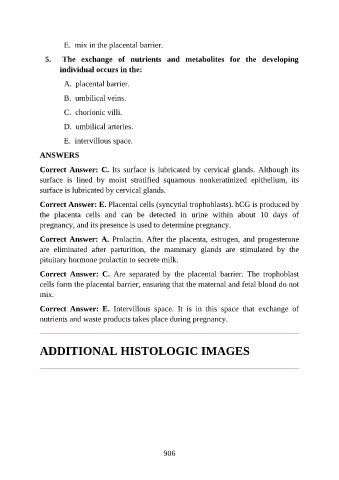Page 907 - Atlas of Histology with Functional Correlations
P. 907
E. mix in the placental barrier.
5. The exchange of nutrients and metabolites for the developing
individual occurs in the:
A. placental barrier.
B. umbilical veins.
C. chorionic villi.
D. umbilical arteries.
E. intervillous space.
ANSWERS
Correct Answer: C. Its surface is lubricated by cervical glands. Although its
surface is lined by moist stratified squamous nonkeratinized epithelium, its
surface is lubricated by cervical glands.
Correct Answer: E. Placental cells (syncytial trophoblasts). hCG is produced by
the placenta cells and can be detected in urine within about 10 days of
pregnancy, and its presence is used to determine pregnancy.
Correct Answer: A. Prolactin. After the placenta, estrogen, and progesterone
are eliminated after parturition, the mammary glands are stimulated by the
pituitary hormone prolactin to secrete milk.
Correct Answer: C. Are separated by the placental barrier. The trophoblast
cells form the placental barrier, ensuring that the maternal and fetal blood do not
mix.
Correct Answer: E. Intervillous space. It is in this space that exchange of
nutrients and waste products takes place during pregnancy.
ADDITIONAL HISTOLOGIC IMAGES
906

